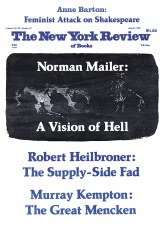In response to:
The Eyes of Ez from the April 30, 1981 issue
To the Editors:
In his review of Harriet Zinnes’s book Ezra Pound and the Visual Arts [NYR, April 30] Lincoln Kirstein writes:
When all cavalier judgments and frantic bullying are condoned, there is left, apart from many brilliant aperçus, personal revelation, and gemlike phrases, two justificatory considerations. Pound persuaded John Quinn, the New York corporation lawyer, to buy some of the greatest contemporary pictures and sculpture, including Seurat’s Le Cirque, Epstein’s best small stone carvings, the Douanier Rousseau’s Sleeping Gypsy, and the finest Brancusi Birds, as well as manuscripts. These have enriched our museums and libraries….
It would be unfortunate if your readers were left with the idea that Pound was responsible for Quinn’s purchase of “some of the greatest contemporary pictures and sculpture.” That credit should go—more than to anyone else—to Quinn’s friend and guide Henri-Pierre Roché, who helped him recover from his earlier excesses in the direction of Augustus John, of Epstein, and of Wyndham Lewis and Pound’s other vorticist friends. At Quinn’s request, Roché concentrated on works of “museum rank and importance,” with such results as Cézanne’s portrait of his father, Seurat’s Le Cirque, and, as his final triumph at the end of a long line of great paintings, the Douanier Rousseau’s Sleeping Gypsy.
Roché was more than a finder: he had the missionary’s sacred fire. Over a period of nearly three weeks in February 1924 he bombarded Quinn almost daily with letters and cables about The Sleeping Gypsy. He reinforced his own urging with opinions from Picasso, Brancusi, Delaunay, and Jacques Doucet. He maneuvered Quinn into taking an option, and when Quinn finally bought the painting, he wrote Roché, “It was your great enthusiasm, never so great about any other work of art, that really bowled me over and prompted me to buy.” (Henri-Pierre Roché archives, Humanities Research Center.)
When the picture reached New York, although it was slightly damaged in transit because of careless packing, Quinn cabled Roché, “Wondrous color and composition. Beautiful, moving, stupendous. [Arthur B.] Davies and others think wonderful. Most grateful your efforts….”
In a letter, now at Yale, which Pound addressed to Henry Allen Moe eight months after Quinn’s death, he wrote, “Quinn was a very sick man during the last years of his life and I could not see eye to eye with his artistic advisers. I don’t doubt that they advised him to buy a good deal of stuff that has advanced in market value….”
Quinn’s pictures had cost him about a half-million dollars. Dumped on the market after his death they fetched about three-quarters of a million, all in.
In his last letter to Roché, written a month before his death, Quinn described in detail on twelve typed pages his disease (cirrhosis of the liver) and its ominous and excruciatingly painful manifestations. He enclosed a draft on a Paris bank for $300 (“I should like to make it $500 but I have been under enormous expense”) “as a slight appreciation of my indebtedness to you in getting me [The Sleeping Gypsy].”
Few were more generous with time and advice than Pound—and on a very broad front. But that should not be allowed to obscure the fact that it was Roché’s eyes rather than Ez’s, chiefly between 1919 and 1924, that persuaded John Quinn to buy the great ones.
Carlton Lake
Humanities Research Center
University of Texas Austin, Texas
This Issue
June 11, 1981



